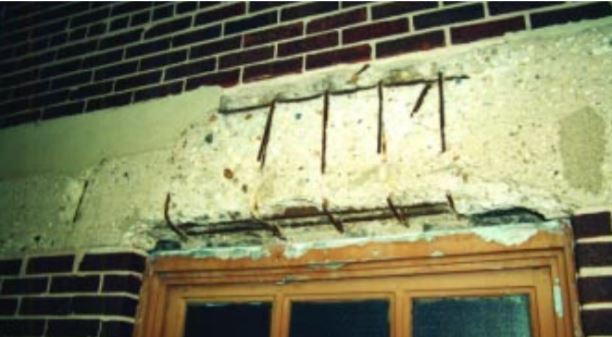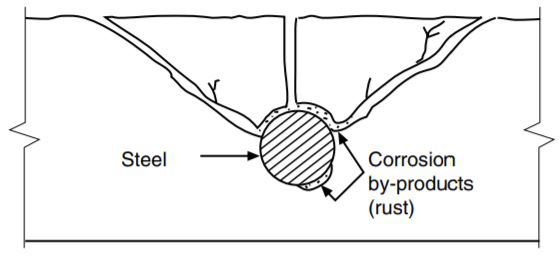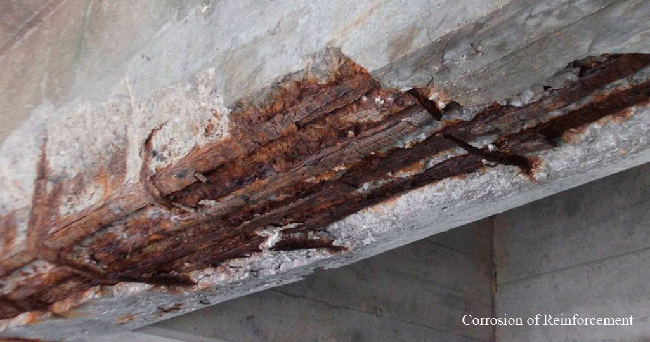
Concrete has excellent durability; that is why it is the most widely used construction material. However, design and construction practices, material limitations, and exposure to severe weather conditions can lead to concrete damage.
This can influence the aesthetic, structural, and functional aspects of a structure.
Several factors such as chemical attacks, overloading and impact, carbonation, dry and wet cycling, and fire can cause significant concrete damage.
Here are the 6 major causes of concrete damage:
1. Carbonation
Carbonation occurs when carbon dioxide penetrates concrete through micro-cracks and pores, reacts with hydroxides like calcium hydroxide, and forms calcium carbonate. The product of the reaction reduces pH in concrete from 13 to 8. The alkalinity reduction exposes embedded steel bars to corrosion. However, carbonation does not increase the rate of steel bar corrosion.
The carbonation of concrete is a slow process. If the quality of concrete is good, the carbonation rate is estimated to be 1 mm/year. Nonetheless, the carbonation rate increases in concrete with low cement content, low strength, short curing period, high water-cement ratio, and high permeability.
Relative humidity of concrete is another factor that controls the rate of carbonation. It reaches its maximum when the relative humidity of concrete is between 50-75%. Therefore, carbonation at a relative humidity of less than 25% can be neglected.
Finally, carbonation affects parts of a concrete building that are directly exposed to rainfall, shaded from sunlight, and have small concrete covers.
 Figure-1: Carbonation-induced Corrosion Often Occurs on Building Facades with Shallow Concrete Cover
Figure-1: Carbonation-induced Corrosion Often Occurs on Building Facades with Shallow Concrete Cover Figure-2: Schematic Illustration of Concrete Carbonation Process
Figure-2: Schematic Illustration of Concrete Carbonation Process
2. Reinforcement Corrosion
Reinforcement corrosion is a leading cause of concrete damage. It occurs when the pH of concrete is reduced to 10 or less, and chloride ions, oxygen, and moisture find their way in.
As a result, the volume of corrosion product (rust) is greater than steel, which stresses the surrounding concrete and makes it crack, delaminate, or spall off.
Corrosion of reinforcement embedded in concrete can be decreased significantly by placing low permeability and crack-free concrete and providing adequate concrete cover over steel bars.
 Figure-3: The expansion of corroding steel creates tensile stresses in the concrete, which can cause cracking, delamination, and spalling
Figure-3: The expansion of corroding steel creates tensile stresses in the concrete, which can cause cracking, delamination, and spalling
3. Chemical Attack
Sulfates of sodium, potassium, calcium, or magnesium dissolved in soil, seawater, or groundwater can penetrate the concrete, react with hydrated compounds, and expand, causing concrete damage. In addition, an internal sulfate attack (delayed ettringite formation) creates a material that absorbs water and causes significant swelling and cracking.
This form of chemical attack is greater in wet and dry cycling conditions. Using a low water-cement ratio and cement with a limited quantity of tricalcium aluminates is the best measure to prevent sulfate attacks.
Acid attack dissolves the binder from the concrete surface, the alkali-aggregate reaction creates an expansive product, and soft water attack erodes cement paste in concrete.
Surface protective treatment of concrete can help avoid an acid attack. In addition, adequately cured concrete with low permeability can reduce the rate of acid attacks.
 Figure-4: Corrosion of Reinforced Concrete Structure Due to Chemical Attacks
Figure-4: Corrosion of Reinforced Concrete Structure Due to Chemical Attacks
4. Overloading and Impacts
The placement of heavy loads on concrete initiates micro-cracks and cracks. In addition, overloading may occur due to changes in the operation of the building without proper structural upgrades, unintentional overloading, and unusual events like earthquakes.
Early removal of formworks or storage of materials or heavy equipment can overload some aspects of a structure. For example, impact equipment can lead to extensive micro-cracking. A common form of impact overload occurs at slab edges of joints on vehicular traffic surfaces.
5. Fire Damage
If concrete is exposed to high heat, it loses most of its compressive strength, flexural strength, and elasticity. Conversely, concrete with a high aggregate-cement ratio suffers less reduction in compressive strength, and the lower the water-cement ratio, the lesser the loss in elastic modulus. As a result, trapped water in concrete can cause spalling.
 Figure-5: Exposure of Concrete Structure to Fire
Figure-5: Exposure of Concrete Structure to Fire
6. Over-Wet ConcreteHigh water content in the concrete mix drives cement to the surface. As a result, the concrete surface will dry before setting occurs, causing shrinkage, cracks, laitance, and reduction of compressive strength.
FAQs
What are the most common causes of concrete deterioration?Chemical attack, overloading and impact, carbonation, dry and wet cycling, and fire are major causes of concrete damages.
What are the causes of reinforcement corrosion in concrete structures?
Reinforcement corrosion occurs when pH in concrete is reduced to 10 or less, and chloride ions, oxygen, and moisture are present.
What is meant by carbonation in concrete?
Carbonation occurs when carbon dioxide penetrates concrete through micro-cracks and pores, reacts with hydroxides like calcium hydroxide, and creates calcium carbonate. The reaction product reduces pH in concrete from 13 to 8.
The alkalinity reduction exposes embedded steel bars to corrosion. The carbonation of concrete is a slow process. If the quality of concrete is high, the carbonation rate is estimated to be 1mm/year.
How can you tell if the concrete is carbonated?
Apply phenolphthalein indicator solution to a fresh fracture surface of the concrete. If the solution remains colorless, the pH of concrete is less than 8.6, suggesting carbonation. However, if the solution turns purple, the pH is above 8.6, and there is no concern for concrete carbonation.